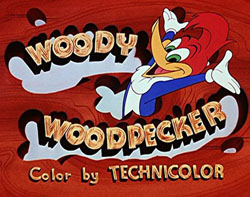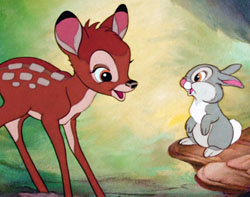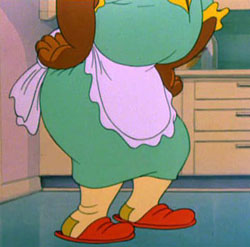 Don’t Ask. Don’t Tell. In the first Pepe LePew cartoon, “Odor-able Kitty” (1945), the amorous French skunk chases a MALE tomcat who has disguised himself as a skunk to avoid abuse from dogs and humans.
Don’t Ask. Don’t Tell. In the first Pepe LePew cartoon, “Odor-able Kitty” (1945), the amorous French skunk chases a MALE tomcat who has disguised himself as a skunk to avoid abuse from dogs and humans.
At the end of the cartoon, it is revealed that Pepe LePew is actually a hen-pecked American skunk named “Henry” with two children and was faking the French accent. Bugs Bunny makes a cameo appearance in the cartoon.
Pepe Le Pew’s name came from the character Pepe Le Moko, a character played by Charles Boyer in the film “Algiers” (1938). Boyer played a romantic French thief who was associated with the phrase “Come with me to the Casbah” that later became a parody of a seductive pick up line.
Actresses and Animation. “I don’t like animation, you know. It gets on my nerves. I don’t like cartoon cartoons. I like the big Disney things, where it’s like characters, but I don’t like stuff like Scooby-Doo and Roadrunner. I can’t watch. But the Disney movies? I love them all. I really, really love them all,” stated actress Julianne Moore in 1999
Whacko Willy. In the late 1980s to demonstrate to Marvel Productions that they could animate in an “American style”, Toei Studios produced a thirty second audition piece entitled “Whacko Willy” featuring three scenes of the Scooby-Doo gang fighting robots. Marvel was unimpressed.
Another Lost Animated Series Pilot. “Firewalk” was an animated series for Universal Cartoon Studios. Tim Truman and Doug Wildey developed this original project that would have dealt with an European kid stranded in South America who tries to make his way to the American colonies. A pilot was produced.
 The Universal Break. In 1947, Lantz went to renegotiate his seven-year Universal contract with Matty Fox, Universal’s Vice President. Universal wanted commercial and licensing rights to the Lantz characters. After some time of arguing, Lantz finally refused Fox’s offer and instead went to George Bagnall of United Artists. Lantz produced a total of twelve cartoons for United Artists before his studio closed again in 1949.
The Universal Break. In 1947, Lantz went to renegotiate his seven-year Universal contract with Matty Fox, Universal’s Vice President. Universal wanted commercial and licensing rights to the Lantz characters. After some time of arguing, Lantz finally refused Fox’s offer and instead went to George Bagnall of United Artists. Lantz produced a total of twelve cartoons for United Artists before his studio closed again in 1949.
The animated sequence of Woody Woodpecker in the George Pal’ movie “Destination Moon” (1950) proved so popular that Lantz returned to Universal (now Universal-International) to renegotiate terms. U-I President, Nate Blumberg, apologized for the demands put forward by his nephew, Matty Fox, three years earlier and agreed to distribute seven cartoons produced by Lantz in 1951. However, he stipulated that, due to the wave of popularity in the wake of the “Woody Woodpecker Song”, all the shorts had to feature Woody Woodpecker. Lantz agreed and his studio went to work to produce the new films.
More Lantz on TV Censorship. In the January 4,1958 issue of TV Guide magazine, animation producer Walter Lantz talked about the difficulty of showing some of his earlier classic cartoons on his television show: “It’s just that continuity acceptance people are more critical of our work than any other type of film. Sure, we have a large children’s audience, but those same kids, a few hours later can see robberies, killing, blood and violence on any number of Western shows. (In our cartoons), a character may be run over by a steam roller but in the very next scene we see that he’s perfectly well and ready for more adventure.”
 The Perfect Squelch. The Saturday Evening Post magazine dated March 22, 1952 reported the following encounter:
The Perfect Squelch. The Saturday Evening Post magazine dated March 22, 1952 reported the following encounter:
A lady with an almost overpowering knowledge of American wildlife of the outdoors kind beset Walt Disney at a Smoke Tree Ranch (Walt’s vacation home) dinner at Palm Springs, California, after Disney’s “Bambi” film was released.
With little ado, she proceeded to tell him in great detail what was wrong with the movie. Most of her criticism was that no deer would actually behave like the woodland creatures in “Bambi”.
“Why in ‘Bambi’,” she said, “the buck steps into the clearing ahead of the doe and fawn to be sure there are no hunters there. Actually, bucks hang back and have even been seen kicking the does out of the brush ahead of them. And the picture wasn’t true to life in other respects, either.”
“How right you are,” Walt broke in gently, “And do you know something else wrong with it? Deers don’t talk.”
 Mammy Two Shoes Version 2.0. In 1962, Chuck Jones was making Tom and Jerry cartoons for MGM. Besides making these shorts, Jones’ crew was also given another assignment. They had to remove “Mammy Two Shoes” from the older Tom and Jerry cartoons because of sensitivity at the time to racial stereotypes.
Mammy Two Shoes Version 2.0. In 1962, Chuck Jones was making Tom and Jerry cartoons for MGM. Besides making these shorts, Jones’ crew was also given another assignment. They had to remove “Mammy Two Shoes” from the older Tom and Jerry cartoons because of sensitivity at the time to racial stereotypes.
Mammy was the maid of the house that Tom lived in. She was generally seen from the knees down and often shuffled through her scenes. When Jerry frightened her, everything from dice to switchblades might fall from her bloomers.
Jones and his team animated white legs over the previously black ones. Animator and producer Phil Roman was part of Jones’ team who did the new legs and recalled, “We were brought in and spent days rotoscoping and re-animating the legs so that they would be thin and white, not thick and black. When we asked what they would do about the Black dialect, they told us they were going to put a funny Irish voice in. We guessed it was all right to make fun of the Irish!”
Forgotten Jiminy Cricket on Radio. The Mercury Theatre of The Air might have ended except for Orson Welles’ return to participate in the radio series House of Lady Esther that sponsored another season of Mercury Theatre in a Drama/Variety format. Called variously, Lady Esther Presents Orson Welles, The Orson Welles Theatre, The Lady Esther Mercury Theatre, or some combination of the three it was a thirty minute program that ran for nineteen episodes on CBS on Monday at 9:00 pm from September 15, 1941 to February 2, 1942.
 This new mixed format also introduced none other than Walt Disney’s Jiminy Cricket in a recurring ‘role’. Jiminy Cricket was supposed to be “bad boy” Orson Welles’ ‘conscience’ throughout the series. The Jiminy Cricket/Orson Welles pairing never really worked according to critics at the time.
This new mixed format also introduced none other than Walt Disney’s Jiminy Cricket in a recurring ‘role’. Jiminy Cricket was supposed to be “bad boy” Orson Welles’ ‘conscience’ throughout the series. The Jiminy Cricket/Orson Welles pairing never really worked according to critics at the time.
Perhaps radio expert Keith Scott who reads this column might offer some further insight on this lost treasure. I assume that Cliff Edwards voiced Jiminy for some extra cash.


 Jim Korkis is an internationally respected animation historian who in recent years has devoted his attention to the many worlds of Disney. He was a columnist for a variety of animation magazines. With his former writing partner, John Cawley, he authored several animation related books including The Encyclopedia of Cartoon Superstars, How to Create Animation, Cartoon Confidential and Get Animated’s Animation Art Buyer’s Guide. He taught animation classes at the Disney Institute in Florida as well as instructing classes on acting and animation history for Disney Feature Animation: Florida.
Jim Korkis is an internationally respected animation historian who in recent years has devoted his attention to the many worlds of Disney. He was a columnist for a variety of animation magazines. With his former writing partner, John Cawley, he authored several animation related books including The Encyclopedia of Cartoon Superstars, How to Create Animation, Cartoon Confidential and Get Animated’s Animation Art Buyer’s Guide. He taught animation classes at the Disney Institute in Florida as well as instructing classes on acting and animation history for Disney Feature Animation: Florida.




















































I recall there being a couple of cartoons that showed Mammy Two-Shoes as being the homeowner, including one where she went out to play cards and socialize with her friends in the evening. As a result, that was always my overriding impression when watching the early Tom & Jerry cartoons, not that she was a maid.
I would think so too. Aside from the Irish made (voiced by June Foray) that appeared in those 60’s redo’s, they used a teenage girl for “Saturday Evening Puss” . Mishandling of the library in later years led to unusual circumstances made unaware in the process. TNT use to play a version of “Saturday Evening Puss” that mixed the wrong audio for the cartoon, so we have the teenage girl dancing with her boyfriend but the audio has her telling someone over the phone this was the “Lucky Seven Saturday Night Bridge Club”. Laughter ensued for the obvious reason!
I have heard the Welles/Cricket pairings under the title “Orson Welles’ Almanac.” The first episode was a series of short pieces narrated by Welles with Jiminy as co-host. The series included a proto talk-show format along the lines of the interviews Fred Allen did on his show. Welles had guest-hosted a few episodes of The Jack Benny Show when Benny was ill, and this was his attempt to break out of straight drama into more of a variety format, with the Cricket intended to soften Orson’s image. It originated from LA but was broadcast regionally for a six-month run. May have been too big a leap for Welles at the time, but he experimented with similar formats in television later.
Though the Pepe Le Moko, character “Algiers” may have been the ultimate inspiration for Pepe LePew, the more direct inspiration was Killer Diller, the wolf-destroying ram, in Frank Tashlin’s “I Got Plenty of Mutton” (1944); the latter also seems to be the inspiration for Jones’ Ralph E. Wolf and Sam Sheepdog cartoons and also seems to have influenced Billy Wilder’s “Some Like it Hot.” By the way, “Algiers” was a remake of the French “Pepe Le Moto” (1937) starring Jean Gabin.
If anyone has a copy of “Whacko Willy”, please contact me.
Lord knows that would be ‘hilarious’ to check out!
I am positive I saw some T & J cartoons in which there was Mammy but the Irish dialect.
I do remember the one with the white woman animated…but it kept the southern dialect.
As Jody Morgan mentioned, more than likely she is intended to be the maid but I can’t think of one cartoon where she couldn’t be assumed as the lady of the house.
That might have been “Saturday Evening Puss” I mentioned elsewhere. That was a case of an odd gaffe in mastering the cartoon where they used the 60’s footage but kept the original audio with Mammy’s voice. I saw it this way around the late 80’s/early 90’s when the cartoon showed up on either TBS or TNT.
Phil Roman might be conflating two different revisions of Mammy Two-Shoes. Most Jones-unit versions of the cartoons left her as pudgy as before—skin color was the only visible difference. In SATURDAY EVENING PUSS, “she” does become thinner; but that’s because rather than being redrawn as a white version of her usual self, she’s redrawn as a faceless version of babysitter Jeannie.
She was quite pudgy I recall, though I haven’t seen those in years. The teenage Jeannie in Saturday Evening Puss I do remember well with the moody voice Foray plays her as.
Of course it didn’t work. As Jiminy Cricket once said “What’s an actor need with a conscience anyway?”